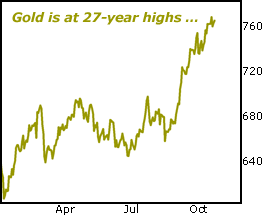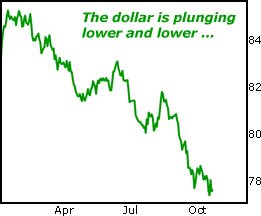Major Turning Point Occurring Now!
Stock-Markets / Inflation Oct 25, 2007 - 10:04 AM GMT Larry Edelson writes: Years from now, we'll look back at this current period in time as a major turning point … when the fires of global inflation were ignited anew … when the world began to realize the dollar was worth no more than the paper it was printed on … and when central bankers became truly known as emperors with no clothes.
Larry Edelson writes: Years from now, we'll look back at this current period in time as a major turning point … when the fires of global inflation were ignited anew … when the world began to realize the dollar was worth no more than the paper it was printed on … and when central bankers became truly known as emperors with no clothes.
You're already seeing it begin, with the U.S. dollar plunging to all-time record lows against nearly all the world's major currencies, and even against dozens of third-world currencies.
Natural resource prices are showing you the same thing. Oil is near $90 a barrel, which was unthinkable just five years ago. Gold has reached 27-year highs, trading at over $760 an ounce. Other commodities from platinum to wheat are hitting record highs.
Governments Can Try to Stop Inflation But They Will Prove Unsuccessful …

Some governments are aware of these problems, and they're taking action. Countries like China, Thailand, and Malaysia are attempting to freeze prices from rising further.
The problem with trying to freeze prices is that it almost always backfires, and creates MORE inflation!
For instance, Nixon's wage and price controls in the early 1970s backfired miserably. Price controls in countries like Nicaragua, Nigeria, Israel, Saudi Arabia — and dozens more — often ended up creating more inflation. Manufacturers and retailers just sold fewer products for the same price. Consumers got less and less for their money. And inflation continued ever higher.
Meanwhile, other countries say that inflation can never get out of control today. They argue that wages aren't rising like they did in the past. Plus, they say central bankers will stamp out inflation by raising interest rates quickly.
Both of those theories are pure baloney! Let me explain …
First, wage inflation is a consequence of inflation, not the cause . After all, people demand higher wages when the cost of living rises. Wage inflation can create a vicious cycle of rising prices though.
In fact, look closely and you'll see that not only are the embers of wage inflation present, but they are beginning to glow with a red-hot intensity.
Average hourly earnings recently jumped a hefty 0.4%, the most since April 2006. Nationwide, unit labor costs were 4.9% higher from a year ago, the largest year-over-year increase since the middle of 2000.
Another component of wage inflation is productivity. If productivity is slowing — even if wages are constant — costs go up for the consumer.
And in the past 12 months, productivity has risen just 0.6% — way down from the 3.6% rate seen during the technology boom.
Bottom line: Wage inflation is coming, you can count on it. That will add even more upside pressure to inflation.
Second, central bankers are not in a position to choke off inflation. Not now, and not in the future.
There's simply too much debt in the world in both the private and public sectors. Period.
The ONLY way for central bankers to alleviate all that debt is to inflate, inflate, inflate. In other words, they will have to devalue the currency to no end.
So when it comes to interest rates, when the central banks of the world begin to recognize that inflation is starting to soar, they might talk tough about controlling it.
But at most, they will raise rates just enough to lag behind inflation!
In fact …
Soon, Government Shenanigans Will Be Seen for What They Truly Are: Enron and WorldCom-Like Deceptions!
Don't get me wrong, I am not just talking about Washington. What I'm talking about is also happening in London, Paris, Brussels, Sao Paulo, Beijing, Bangkok — in every corner of the globe.
For many years now, all the people in power have been telling their citizens that inflation is not a problem … that it's running at 2%, 3%, or some other made-up figure.
And like corporate book cookers, they've come up with hairball schemes to justify their absurdly low inflation figures.
Example: The so-called "hedonic adjustments," which basically slash inflation rates based on the government's subjective opinion of how improved today's products are and converting them into price declines.
Even more absurd is when they leave out essential items that anyone who breathes must use — such as energy and food — considering such expenses extraneous to the "core inflation rate."
So the oil, gas and food prices can be going through the roof, as they are now, and "inflation" remains stable.
Look, these tactics are just like the ones WorldCom or Enron used to deceive investors. And they always work for a while. But eventually, people begin to get suspicious and the whole house of cards comes tumbling down.
Already, there are rumblings in the distance:
![]() Protests on gas prices have erupted in at least nine countries.
Protests on gas prices have erupted in at least nine countries.
![]() Angry mobs from Mexico to Ho Chi Min City have convened upon government offices protesting food prices.
Angry mobs from Mexico to Ho Chi Min City have convened upon government offices protesting food prices.
![]() In Mumbai, and New Delhi, no less than five mob gatherings in the past two weeks have seen tens of thousands protesting everything from energy prices to the price of locally grown rice.
In Mumbai, and New Delhi, no less than five mob gatherings in the past two weeks have seen tens of thousands protesting everything from energy prices to the price of locally grown rice.
Governments should take heed: You can fool some of the people some of the time, but you can't fool all of the people all of the time!
How High Will Inflation Go? What Signals Should You Watch?
My estimate currently puts real world inflation between 8% and 10%. I'm sure you'll agree with that based on the prices you're seeing at the gas pump, the grocery store, and in healthcare and college tuition bills.

And based on what gold and oil are doing, I'd venture to say that inflation could easily DOUBLE to as high as 20% — even in the U.S. — before this inflation cycle runs its course, which has at least four years to go.
Look at it this way: The last time gold traded at $760 an ounce, inflation was running at almost 18%. Gold is there now — and it tends to lead, not lag, the inflation rate.
Believe me, I would prefer to be wrong about all this. But that's just not in the cards. Governments around the world have been playing with inflation figures for years and the jig is just about up.
Here are four signals you can use to see what inflation is really doing:
Signal #1: The value of the dollar. As the dollar weakens further, foreign goods cost you more. Period.
The dollar has already hit record lows. It could bounce a bit, but the main trend is down, for all the reasons I mentioned above.
Specifically, watch the U.S. Dollar Index (DXY), which compares the dollar to a basket of major currencies. We frequently run this chart in Money and Markets , but you can monitor the dollar index in the "Money & Investing" section of The Wall Street Journal .

Signal #2: Treasury bond prices. Keep your eyes on bonds because they are extremely sensitive to inflation. When bond traders smell inflation, they sell bonds. That depresses bond prices and effectively increases long-term interest rates.
Right now, bonds have been holding up okay. But that's only because of the real estate carnage in the U.S. As soon as bond traders get a whiff of inflation, bonds could fall like a rock.
Signal #3: The Commodity Research Bureau Index. When somebody tries to tell you there's no inflation, ask why the CRB index has jumped 48.7% in the last five years … and 11% in barely two months!
Keep an eye on this index, which contains a basket of popular commodities. While it will take breathers from time to time, as long as it remains above the 664 level (currently 807), inflation is building momentum.
You can also monitor the CRB index in the "Money & Investing" section of The Wall Street Journal .
Signal #4: The price of gold. Historically, gold has been an extraordinarily accurate leading indicator of inflation because, for centuries, it's maintained a basically stable value in terms of purchasing power.
And true to history, gold is on fire, hitting 27-year highs. I think you will see it explode even higher going forward.
Take the Following Steps to Protect Your Money from the Ravages of a Falling Dollar and Rising Inflation
Step #1. Make sure you have your core gold holdings in order. On September 6, just before the recent huge gold rally, I suggested upping your allocation from 5% to 10%, doubling your allocation in gold.
Two gold funds I like are the DWS Gold & Precious Metal Fund (SCGDX) and the Tocqueville Gold Fund (TGLDX).
Step #2. If you're still in long-term government and corporate bonds, consider getting out immediately. As I explained earlier, traders will sell these investments whenever they smell inflation.
Step #3. To hedge directly against the declining dollar, you can buy the Falling U.S. Dollar Profund (FDPIX) mutual fund. When the dollar is sinking, this fund rises in value. It's available through most brokerage firms or through ProFunds directly ( www.profunds.com ; phone: 1-888-776-3637). The minimum investment is $15,000.
Step #4: Don't ignore other key natural resource stocks. Since almost all of these investments are traded in dollar terms, they press higher whenever the greenback falls. Add in the three billion new consumers in Asia, especially in China and India, and you can see why buying natural resource investments is a no-brainer in my opinion.
Best wishes,
Larry
This investment news is brought to you by Money and Markets . Money and Markets is a free daily investment newsletter from Martin D. Weiss and Weiss Research analysts offering the latest investing news and financial insights for the stock market, including tips and advice on investing in gold, energy and oil. Dr. Weiss is a leader in the fields of investing, interest rates, financial safety and economic forecasting. To view archives or subscribe, visit http://www.moneyandmarkets.com .
Money and Markets Archive |
© 2005-2022 http://www.MarketOracle.co.uk - The Market Oracle is a FREE Daily Financial Markets Analysis & Forecasting online publication.



